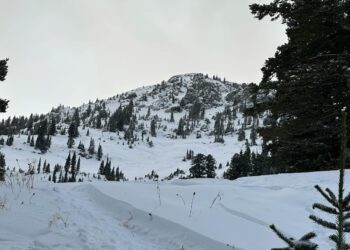How SNOTEL sites provide crucial data about local snowpack and river health
By Mario Carr EBS CONTRIBUTOR
As a resort community, measuring snow is an important science in Big Sky. Thanks to a network of over 900 automated data collection sites – called SNOTEL, or Snow Telemetry – located in remote, high-elevation mountain watersheds in the western U.S., that data can be carefully monitored.
The Lone Mountain SNOTEL in Big Sky is just one of 96 SNOTEL stations located in Montana, and is situated at 8,800 feet. This station, like all SNOTEL sites, has been designed to operate unattended and without maintenance for a year or more. At this site, there is equipment collecting data on snow water equivalent, snow depth and air temperatures every hour since it was created in 1989.
Zachary Hoylman, a hydrologist and a state climatologist in Montana, helped break down the importance of these SNOTEL stations.
“SNOTELs are meteorological stations that are typically distributed at relatively high elevations, and the intent is to basically measure snowpack in locations that are experiencing quite a bit of snow,” Hoylman said.
“What makes SNOTELs really really unique is that they measure what’s called ‘snow water equivalent,’ and snow water equivalent is effectively the amount of water that would be stored in the snowpack,” Hoylman said.
SNOTEL stations use what is called a “snow pillow” to measure the SWE. These pillows weigh the snow that has fallen with a pressure transducer, and are then able to calculate density and water content of the snow.

“There’s a known relationship between the volume of water and the weight of the water, because it’s a non-compressible fluid,” Hoylman said.
SNOTEL stations provide foundational data sets for our understanding of the environment in the Rocky Mountains according to Hoylman, and there are sites that have been recording data for 50 years. The data from SNOTEL is fed into a snow data assimilation system, which produces a hydrological model to try and create a more complete picture of the snowpack between all of the SNOTEL stations.
“SNOTEL is the foundational snowpack monitoring network that we’ve used for literally decades to understand our water sources, predict things like stream flow, and it’s a really key piece of the hydrological puzzle,” Hoylman said.
As we seek to understand our environment, SNOTEL sites are very helpful in determining expected streamflow and water availability, but when it comes to predicting something like the likelihood of forest fires, Hoylman said that there are many other variables in that equation. Hoylman said that this winter, snow events in late February and early March have greatly improved our snowpack in Montana.
“We’ve had several good snow events and so things have improved quite a bit. But we’re still below average for sure when it comes to snowpack dynamics and snow pack storage. At this point I think we can expect lower runoff,” Hoylman said.
Understanding our snowpack in the Rockies is essential to understanding the environment. Communities in the Rocky Mountains depend heavily on the rise and fall of our snowpack through the winter, and the subsequent ebbing and flowing of our streams and rivers in the summer.
On the topic of the transition from snowpack to snowmelt, Andrew Larson, a professor of forest ecology at the University of Montana, explained how SNOTELs can help us understand the effect of snowpack on the ecosystem post-wintertime.
“There’s a big switch that gets flipped on the landscape as the snow melts out and you move into spring green-up,” Larson said.
Larson explained that after the snowpack has melted, that summer weather has the greatest impact on fire likelihood, and that the moisture of those forest fire fuels in the dryer summer months is the biggest factor in the likelihood of a burn. And that the longer the snowpack remains, the longer those fuels are likely to remain too wet to burn.
“We’re in a position right now with our well below average snowpacks that we would expect the fuels to become available to burn earlier… There’s preconditioning right now, so it doesn’t guarantee that we’re going to have a bad fire season, but we sure could, because we’re going in dry,” Larson said.
Our Lone Mountain SNOTEL data tells us that our snowpack and SWE this winter have consistently been roughly 50% of last year’s values month-over-month. With a wet spring and summer last year, we were thankful to enjoy a green landscape with minimal fires. Not knowing what the next season holds quite yet, SNOTEL data can help us be prepared by understanding the current season we are in.











